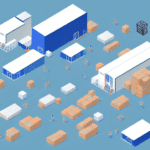What Are Logistics Costs and How Do You Calculate Them?
Logistics plays a crucial role in any business, as it involves the management of the flow of goods from their origin to the final destination. However, this process often comes with a price tag, known as logistics costs. Logistics costs refer to the expenses incurred by businesses to manage the movement and storage of their products, including transportation, warehousing, inventory, labor, and handling costs. In this article, we will explore the various types of logistics costs and how to calculate and manage them effectively to improve your business’s bottom line.
The Importance of Accurately Calculating Logistics Costs
Accurately calculating logistics costs is critical for any business that wants to optimize its supply chain and improve its profitability. Understanding the costs involved in the logistics process helps businesses make informed decisions about their pricing, inventory management, transportation, distribution, and vendor selection. By knowing the exact costs associated with each aspect of their supply chain, businesses can identify areas of inefficiency and implement strategies to reduce expenses and improve their bottom line.
Moreover, accurate logistics cost calculation also helps businesses to negotiate better rates with their logistics service providers. When businesses have a clear understanding of their logistics costs, they can negotiate with their logistics service providers from a position of strength. This can result in better rates, improved service levels, and stronger relationships with logistics partners. In addition, accurate logistics cost calculation can also help businesses to identify opportunities for outsourcing certain aspects of their supply chain, which can further reduce costs and improve efficiency.
Types of Logistics Costs
When it comes to calculating logistics costs, there are many expenses to consider, including direct and indirect costs. Direct logistics costs are expenses that are directly related to the movement and storage of goods, such as transportation, warehousing, and inventory costs. Indirect logistics costs, on the other hand, are expenses that are not directly related to the production or delivery of goods but can still affect the logistics process, such as equipment maintenance, insurance, and administration costs.
Another type of logistics cost to consider is reverse logistics costs. These are the costs associated with the movement of goods from the customer back to the manufacturer or supplier. This can include returns, repairs, and recycling or disposal of products. Reverse logistics costs can be significant and should be factored into overall logistics cost calculations.
In addition to these costs, there are also external logistics costs to consider. These are expenses that are incurred outside of the company’s control, such as tariffs, taxes, and fees imposed by government agencies or transportation providers. These costs can vary widely depending on the country or region in which the company operates and can have a significant impact on overall logistics costs.
Direct vs Indirect Logistics Costs: What’s the Difference?
The main difference between direct and indirect logistics costs is that direct costs are more controllable and can be easily attributed to the movement and storage of specific products, while indirect costs are less controllable and can vary depending on several factors. Direct logistics costs are more predictable and can be calculated based on the volume of goods transported or stored, while indirect costs are more difficult to quantify and often require estimation.
Examples of direct logistics costs include transportation expenses, warehouse rental fees, and labor costs for loading and unloading goods. These costs are directly related to the physical movement and storage of products. On the other hand, indirect logistics costs can include expenses such as insurance, taxes, and administrative costs. These costs are not directly related to the physical movement of products but are necessary for the overall operation of the logistics system.
Factors That Affect Logistics Costs
Several factors can affect logistics costs, including the type of product being transported, the distance and mode of transportation, the volume of goods being shipped, and the location and capacity of storage facilities. Other factors such as fuel prices, labor costs, regulations, weather conditions, and market demand can also impact logistics costs. To accurately calculate logistics costs, it is essential to consider all these factors and their potential impact on the supply chain.
The type of packaging used for the products being transported can also affect logistics costs. For example, fragile or perishable items may require specialized packaging and handling, which can increase transportation and storage costs. On the other hand, using eco-friendly packaging materials can help reduce logistics costs by minimizing the weight and volume of the shipment.
In addition, the level of automation in the supply chain can impact logistics costs. Automated systems can help reduce labor costs and improve efficiency, but they require significant upfront investment. The level of automation needed will depend on the size and complexity of the supply chain, as well as the specific needs of the business.
Understanding Transportation Costs in Logistics
Transportation costs are the expenses incurred in moving goods from one location to another. These costs can vary depending on the mode of transportation used, such as air, water, road, or rail, and the distance traveled. Some factors that can affect transportation costs include fuel prices, equipment maintenance, vehicle capacity, transportation regulations, and surcharges. To calculate transportation costs accurately, businesses must consider all these factors and evaluate the most cost-effective transportation options for their products.
One important factor that can affect transportation costs is the type of goods being transported. Some products may require specialized equipment or handling, which can increase transportation costs. For example, transporting hazardous materials may require additional safety measures and certifications, which can add to the overall cost of transportation.
In addition, transportation costs can also be influenced by external factors such as weather conditions and geopolitical events. Natural disasters or political unrest in certain regions can disrupt transportation routes and increase costs. Therefore, businesses must also consider these external factors when evaluating transportation options and planning logistics operations.
Warehousing & Inventory Costs in Logistics
Warehousing and inventory costs are expenses associated with storing goods in a warehouse or other storage facility. These costs can include rent, utilities, labor, equipment maintenance, insurance, and security. Inventory costs refer to the expenses associated with holding and managing inventory, such as purchasing, storage, and handling costs. To calculate warehousing and inventory costs accurately, businesses must evaluate the cost of their storage facilities, their inventory levels, and their inventory turnover rate.
One of the biggest challenges in managing warehousing and inventory costs is finding the right balance between having enough inventory to meet customer demand and minimizing the costs associated with excess inventory. Businesses must carefully analyze their sales data and market trends to determine the optimal inventory levels for their products.
In addition to the direct costs of warehousing and inventory, there are also indirect costs to consider. For example, excess inventory can lead to increased obsolescence and waste, which can have a negative impact on a company’s bottom line. Similarly, poor inventory management can result in stockouts, which can lead to lost sales and dissatisfied customers.
Labor & Handling Costs in Logistics
Labor and handling costs refer to the expenses associated with hiring and training personnel to manage the logistics process, such as drivers, warehouse staff, and administrative personnel. Handling costs refer to the expenses associated with loading and unloading goods, preparing products for transportation, and packaging. To calculate labor and handling costs accurately, businesses must evaluate their staffing levels, hourly rates, and productivity rates.
In addition to staffing levels, hourly rates, and productivity rates, businesses must also consider the impact of labor and handling costs on their overall logistics budget. These costs can vary depending on the type of goods being transported, the distance traveled, and the mode of transportation used. For example, handling costs may be higher for fragile or hazardous goods that require special packaging and handling procedures. By carefully analyzing labor and handling costs, businesses can identify areas for cost savings and improve their overall logistics efficiency.
Technology & System Costs in Logistics
Technology and system costs refer to the expenses associated with implementing and maintaining logistics software and hardware. These costs can include the purchase or lease of transportation management systems, warehouse management systems, inventory management systems, and other software and hardware tools. To calculate technology and system costs accurately, businesses must consider the upfront costs, ongoing maintenance costs, and the return on investment for their technology investments.
Hidden and Miscellaneous Logistics Costs to Consider
There are many hidden and miscellaneous logistics costs to consider when calculating overall logistics costs. These can include insurance premiums, customs fees, government regulations, subcontractor fees, and other unexpected costs that may arise during the logistics process. To calculate hidden and miscellaneous costs accurately, businesses must carefully review all aspects of their logistics process and consider potential risks and unknown expenses that may arise.
Best Practices for Managing and Reducing Logistics Costs
To effectively manage and reduce logistics costs, businesses can implement several best practices. These can include optimizing transportation routes and modes, improving warehouse and inventory management, implementing cost-effective technology solutions, negotiating favorable rates with vendors and carriers, and consistently analyzing and evaluating logistics data to identify areas of improvement and cost savings.
Tracking and Analyzing Your Logistics Costs Over Time
Tracking and analyzing logistics costs over time is critical for identifying trends and areas of inefficiency in the supply chain. By monitoring logistics data, businesses can identify areas of improvement, such as reducing transportation costs, improving inventory turnover, and optimizing staff productivity. It is essential to consistently monitor and analyze logistics data to adjust strategies and improve logistics management continually.
Tools and Software for Calculating and Managing Your Logistics Costs
There are many software and technology solutions available to help businesses calculate and manage their logistics costs. These can include transportation management systems, warehouse management systems, inventory management systems, and other logistics software tools. By using software and technology solutions, businesses can automate certain aspects of logistics management, reduce errors and inefficiencies, and optimize their supply chain management.
How to Negotiate Better Rates with Your Vendors and Carriers
Negotiating better rates with vendors and carriers is essential for reducing logistics costs. Businesses can negotiate on several factors, such as the volume of goods shipped, the frequency of shipments, and the mode of transportation used. By building strong relationships with vendors and carriers, businesses can negotiate favorable rates and reduce their overall logistics expenses.
The Future of Logistics Cost Management: Trends and Innovations
Innovations in technology and automation are driving significant changes in logistics cost management. Predictive analytics, machine learning, and artificial intelligence are becoming increasingly prevalent in logistics software and tools, allowing businesses to optimize their supply chain and reduce costs. The future of logistics cost management will likely prioritize automation, data analytics, and real-time monitoring to improve supply chain efficiency and reduce expenses.
Overall, understanding and managing logistics costs are crucial for any business that wants to improve its supply chain and bottom line. By accurately calculating logistics costs and implementing cost-effective strategies, businesses can optimize their supply chain management, reduce expenses, and improve their profitability.




















